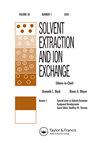Gamma Radiolysis of Phenyl-Substituted TODGAs: Part II
IF 2.1
4区 化学
Q3 CHEMISTRY, MULTIDISCIPLINARY
引用次数: 1
Abstract
ABSTRACT The radiolytic degradation chemistry of three phenylated analogs of N,N,N’,N’-tetraoctyl diglycolamide (TODGA) was investigated: 2-(2-(di-n-octylamino)-2-oxoethoxy)-N,N-di-n-octyl-2-phenylacetamide (PhTODGA), which has a phenyl substituent bound to a central methylene, 2-(2-(di-n-octylamino)-2-oxo-1-phenylethoxy)-N,N-di-n-octylpropanamide (PhMeTODGA), which also contains a methyl substituent bound to the methylene on the other side of the ether moiety, and, 2-(2-N-n-hexyl-N-phenylamino)-2-oxoethoxy)-N-n-hexyl-N-phenylacetamide (DHDPDGA), which has phenyl substituents located on the amide groups instead of the central methylenes. In Part II of this series of papers radiolytic degradation products were identified after separation with liquid chromatography by High Resolution, Accurate-Mass mass spectrometry and collision-induced dissociation. At least twenty-two radiolytic degradation products were identified for PhTODGA, twenty-nine for PhMeTODGA, and over three dozen for DHDPDGA. The suite of radiolytic degradation products of these three investigated ligands was significantly larger than has been reported for previously studied diglycolamides, owing to their asymmetric nature, and to the identification of several new degradation mechanisms, including addition of methyl, hydroxyl, and nitrogen oxide radicals, that have not been previously reported for diglycolamides. Degradation products that contained addition of a NO2 or NO3 group were particularly prevalent for DHDPDGA, likely due to the phenyl side-groups. Several of these newly observed mechanisms do not appear to depend on the presence of the phenyl groups, suggesting these novel mechanisms may apply to other diglycolamides苯基取代TODGAs的γ辐射分解:第二部分
研究了三种苯基化N,N,N ',N ' -四辛基二甘醇酰胺(TODGA)的辐射降解化学性质。2-(2-(二-正辛胺)-2-氧乙氧基)- n, n-二-正辛基-2-苯乙醯乙酰胺(PhTODGA),它有一个苯基取代基与中心亚甲基结合,2-(二-正辛胺)-2-氧-1-苯乙氧基)- n, n-二-正辛基-2-苯乙醯丙酰胺(PhMeTODGA),它也含有一个甲基取代基与醚部分另一侧的亚甲基结合,以及2-(2- n-正己基-n-苯基苯基)-2-正己基-n-苯基乙醯乙酰胺(DHDPDGA)。苯基取代基位于酰胺基上而不是中间的亚甲基上。在本系列论文的第二部分中,通过液相色谱、高分辨率、精确质谱和碰撞诱导解离分离,对辐射降解产物进行了鉴定。PhTODGA至少鉴定出22种放射性降解产物,PhMeTODGA鉴定出29种,DHDPDGA鉴定出超过36种。由于这三种配体的不对称性质,以及发现了几种新的降解机制,包括甲基自由基、羟基自由基和氮氧化物自由基的加入,这在以前的二糖酰胺研究中没有报道过,因此这三种配体的辐射降解产物明显大于先前报道的二糖酰胺。含有NO2或NO3基团的降解产物对DHDPDGA尤其普遍,可能是由于苯基侧基。这些新观察到的机制中的一些似乎并不依赖于苯基的存在,这表明这些新的机制可能适用于其他二醇酰胺
本文章由计算机程序翻译,如有差异,请以英文原文为准。
求助全文
约1分钟内获得全文
求助全文
来源期刊
CiteScore
4.40
自引率
5.00%
发文量
15
审稿时长
8.4 months
期刊介绍:
Solvent Extraction and Ion Exchange is an international journal that publishes original research papers, reviews, and notes that address all aspects of solvent extraction, ion exchange, and closely related methods involving, for example, liquid membranes, extraction chromatography, supercritical fluids, ionic liquids, microfluidics, and adsorption. We welcome submissions that look at: The underlying principles in solvent extraction and ion exchange; Solvent extraction and ion exchange process development; New materials or reagents, their syntheses and properties; Computational methods of molecular design and simulation; Advances in equipment, fluid dynamics, and engineering; Interfacial phenomena, kinetics, and coalescence; Spectroscopic and diffraction analysis of structure and dynamics; Host-guest chemistry, ion receptors, and molecular recognition.

 求助内容:
求助内容: 应助结果提醒方式:
应助结果提醒方式:


